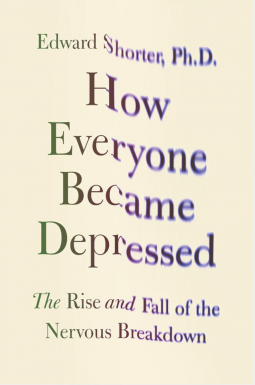
How Everyone Became Depressed
The Rise and Fall of the Nervous Breakdown
by Edward Shorter
This title was previously available on NetGalley and is now archived.
Buy on Amazon
Buy on BN.com
Buy on Bookshop.org
*This page contains affiliate links, so we may earn a small commission when you make a purchase through links on our site at no additional cost to you.
Send NetGalley books directly to your Kindle or Kindle app
1
To read on a Kindle or Kindle app, please add kindle@netgalley.com as an approved email address to receive files in your Amazon account. Click here for step-by-step instructions.
2
Also find your Kindle email address within your Amazon account, and enter it here.
Pub Date Mar 01 2013 | Archive Date Jan 22 2013
Description
The book argues that psychiatry's love affair with the diagnosis of
depression has become a death grip. Depression is a real illness,
especially in its melancholic form. But most patients who get the
diagnosis of "depression" are also anxious, fatigued, unable to sleep,
have all kinds of physical symptoms, and tend to obsess about the whole
thing. They do not have a disorder of "mood." It is a travesty to call
them all "depressed." How did this happen? How did everyone become
depressed? A well-known historian, Shorter describes how in the 19th
century patients with those symptoms were considered "nervous," and when
they lost control it was a "nervous breakdown." Then psychiatry turned
its back on the whole concept of nerves, and - first under the
influence of Freud's psychoanalysis and then the influence of the
pharmaceutical industry - the diagnosis of depression took center
stage. The result has been a scientific disaster, leading to the
misdiagnosis and inappropriate treatment (with "antidepressants") of
millions of patients. Urging that the diagnosis of depression be
re-thought, the book turns a dramatic page in the understanding of
psychiatric symptoms that are as common as the common cold.
The book makes an immediate contribution to the debate about DSM5, which is scheduled to be published in May 2013 just as Shorter's book is launched: Shorter proposes replacing the diagnosis of "major depression" with "melancholia" and "nonmelancholia"; he argues that depression and anxiety usually occur together and are really the same disease; and he says that patients with so-called mood disorders really have a disorder of the entire body. All of this will be highly unwelcome to the official disease designers of DSM5 because it involves throwing out much of their schema.
The book's edge is its ability to make the enormous well of psychiatry's past history in several languages relevant to burning issues today. No other writer has been able to glean nuggets of gold from this huge record of the past and apply them to important discussions today of diagnosis and treatment.
The book makes an immediate contribution to the debate about DSM5, which is scheduled to be published in May 2013 just as Shorter's book is launched: Shorter proposes replacing the diagnosis of "major depression" with "melancholia" and "nonmelancholia"; he argues that depression and anxiety usually occur together and are really the same disease; and he says that patients with so-called mood disorders really have a disorder of the entire body. All of this will be highly unwelcome to the official disease designers of DSM5 because it involves throwing out much of their schema.
The book's edge is its ability to make the enormous well of psychiatry's past history in several languages relevant to burning issues today. No other writer has been able to glean nuggets of gold from this huge record of the past and apply them to important discussions today of diagnosis and treatment.
Available Editions
| EDITION | Hardcover |
| ISBN | 9780199948086 |
| PRICE | $29.95 (USD) |



